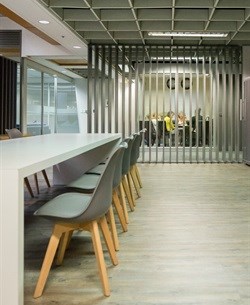Neuroscience research shows correlation between workspace design and sales results
Selling has become significantly more difficult in a market where products are commoditised and an agile, responsive salesperson is often the most significant competitive edge that a company has. A workplace that achieves synchronicity between selling and experience at every touch point is more important than ever.

Research shows that every worker’s physiology and psychology is altered by the neurotransmissions their headspace produces – shaping each owner’s thoughts, heart and hands as they shift. With so many variables in the broader environment, the first step to motivating a successful salesperson is doubtless to design a workplace that will help them achieve their full potential.
However, workplaces for sales people are often disabling rather than enabling, leading to disinterest and disengagement.
Gallup’s State of The Global Workplace Report (2013) revealed that across all job titles in sub-Saharan Africa, salespeople are the least engaged or motivated in the workplace (ie just 5% of salespeople are engaged, compared to mineworkers at 12%). By investigating the neuroscience behind human behaviour, it is easy to understand why.
Too much stimuli overloads brain
Tower Bridge neuroscience consultant, Ian Rheeder, says that our prefrontal cortex (PFC) – the thinking and problem solving part of our brain – cannot function when bombarded by too much stimuli through our senses. Even the slightest irritation drains blood from the PFC to the survival parts of our brain, causing the PFC to shut down.
Maintaining blood flow in our PFC is not easy when you are stressed. Under these conditions, salespeople lose the very tools that they need the most – their ability listen to customers, build trust, handle objections with empathy and problem solve.
Workplace design can respond to two specific types of sales behaviour, relationship-oriented (heart) and task-oriented (hand) and functional workplace design assists both. Businesses that adapt workplace design to meet the needs of internal and external sales staff create the right environment for them to become more productive and satisfied.
Good workspace design increases results
Workspaces that recognise the unique work done by salespeople and enable their work by providing the right space drive up sales because when the correct cluster of drugs or hormones – serotonin, dopamine and oxytocin – is combined, it is a powerful concoction that drives better resonance, engagement, communication and social skills, which are all essential traits of a successful salesperson.
Workplaces that integrate all the critical influences that affect the human psyche get results and those that do not, fail. By combining an enabling physical space and work environment with an engaging leadership style and organisational culture, the right mix of the neurotransmitters can be achieved and maintained – delivering big paybacks.
Neuroscience research shows that there is a clear correlation between workspace design, workplace culture and the attitudes and energy of general staff and sales teams – and that these energies and attitudes present the face of your brand in unexpected ways.
They are apparent in face-to-face meetings, on the showroom floor and in presentations – but they also make their way to customers via emails, telephone calls and Skype calls, with passive or active emotions stimulated by the workplace becoming unintentionally obvious.

































